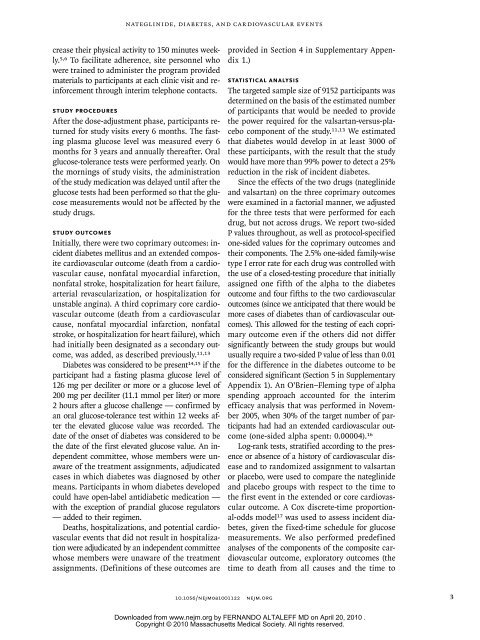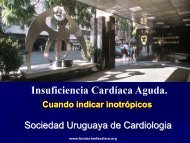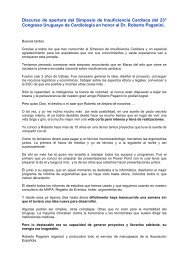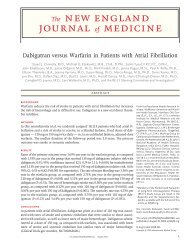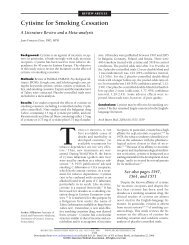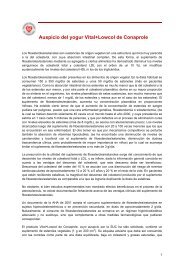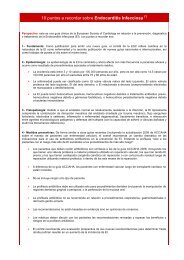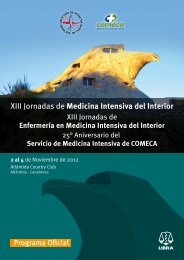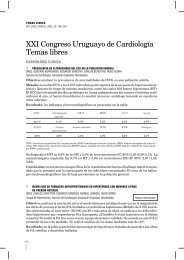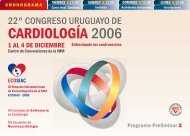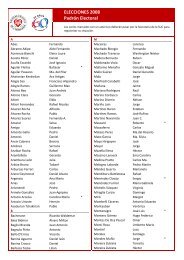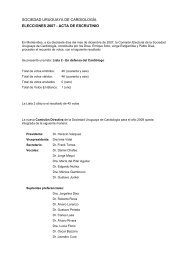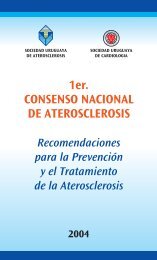Effect of Nateglinide on the Incidence of Diabetes and ...
Effect of Nateglinide on the Incidence of Diabetes and ...
Effect of Nateglinide on the Incidence of Diabetes and ...
Create successful ePaper yourself
Turn your PDF publications into a flip-book with our unique Google optimized e-Paper software.
<str<strong>on</strong>g>Nateglinide</str<strong>on</strong>g>, <strong>Diabetes</strong>, <strong>and</strong> Cardiovascular Events<br />
crease <strong>the</strong>ir physical activity to 150 minutes weekly.<br />
5,6 To facilitate adherence, site pers<strong>on</strong>nel who<br />
were trained to administer <strong>the</strong> program provided<br />
materials to participants at each clinic visit <strong>and</strong> reinforcement<br />
through interim teleph<strong>on</strong>e c<strong>on</strong>tacts.<br />
Study Procedures<br />
After <strong>the</strong> dose-adjustment phase, participants returned<br />
for study visits every 6 m<strong>on</strong>ths. The fasting<br />
plasma glucose level was measured every 6<br />
m<strong>on</strong>ths for 3 years <strong>and</strong> annually <strong>the</strong>reafter. Oral<br />
glucose-tolerance tests were performed yearly. On<br />
<strong>the</strong> mornings <str<strong>on</strong>g>of</str<strong>on</strong>g> study visits, <strong>the</strong> administrati<strong>on</strong><br />
<str<strong>on</strong>g>of</str<strong>on</strong>g> <strong>the</strong> study medicati<strong>on</strong> was delayed until after <strong>the</strong><br />
glucose tests had been performed so that <strong>the</strong> glucose<br />
measurements would not be affected by <strong>the</strong><br />
study drugs.<br />
Study Outcomes<br />
Initially, <strong>the</strong>re were two coprimary outcomes: incident<br />
diabetes mellitus <strong>and</strong> an extended composite<br />
cardiovascular outcome (death from a cardiovascular<br />
cause, n<strong>on</strong>fatal myocardial infarcti<strong>on</strong>,<br />
n<strong>on</strong>fatal stroke, hospitalizati<strong>on</strong> for heart failure,<br />
arterial revascularizati<strong>on</strong>, or hospitalizati<strong>on</strong> for<br />
unstable angina). A third coprimary core cardiovascular<br />
outcome (death from a cardiovascular<br />
cause, n<strong>on</strong>fatal myocardial infarcti<strong>on</strong>, n<strong>on</strong>fatal<br />
stroke, or hospitalizati<strong>on</strong> for heart failure), which<br />
had initially been designated as a sec<strong>on</strong>dary outcome,<br />
was added, as described previously. 11,13<br />
<strong>Diabetes</strong> was c<strong>on</strong>sidered to be present 14,15 if <strong>the</strong><br />
participant had a fasting plasma glucose level <str<strong>on</strong>g>of</str<strong>on</strong>g><br />
126 mg per deciliter or more or a glucose level <str<strong>on</strong>g>of</str<strong>on</strong>g><br />
200 mg per deciliter (11.1 mmol per liter) or more<br />
2 hours after a glucose challenge — c<strong>on</strong>firmed by<br />
an oral glucose-tolerance test within 12 weeks after<br />
<strong>the</strong> elevated glucose value was recorded. The<br />
date <str<strong>on</strong>g>of</str<strong>on</strong>g> <strong>the</strong> <strong>on</strong>set <str<strong>on</strong>g>of</str<strong>on</strong>g> diabetes was c<strong>on</strong>sidered to be<br />
<strong>the</strong> date <str<strong>on</strong>g>of</str<strong>on</strong>g> <strong>the</strong> first elevated glucose value. An independent<br />
committee, whose members were unaware<br />
<str<strong>on</strong>g>of</str<strong>on</strong>g> <strong>the</strong> treatment assignments, adjudicated<br />
cases in which diabetes was diagnosed by o<strong>the</strong>r<br />
means. Participants in whom diabetes developed<br />
could have open-label antidiabetic medicati<strong>on</strong> —<br />
with <strong>the</strong> excepti<strong>on</strong> <str<strong>on</strong>g>of</str<strong>on</strong>g> pr<strong>and</strong>ial glucose regulators<br />
— added to <strong>the</strong>ir regimen.<br />
Deaths, hospitalizati<strong>on</strong>s, <strong>and</strong> potential cardiovascular<br />
events that did not result in hospitalizati<strong>on</strong><br />
were adjudicated by an independent committee<br />
whose members were unaware <str<strong>on</strong>g>of</str<strong>on</strong>g> <strong>the</strong> treatment<br />
assignments. (Definiti<strong>on</strong>s <str<strong>on</strong>g>of</str<strong>on</strong>g> <strong>the</strong>se outcomes are<br />
provided in Secti<strong>on</strong> 4 in Supplementary Appendix<br />
1.)<br />
Statistical Analysis<br />
The targeted sample size <str<strong>on</strong>g>of</str<strong>on</strong>g> 9152 participants was<br />
determined <strong>on</strong> <strong>the</strong> basis <str<strong>on</strong>g>of</str<strong>on</strong>g> <strong>the</strong> estimated number<br />
<str<strong>on</strong>g>of</str<strong>on</strong>g> participants that would be needed to provide<br />
<strong>the</strong> power required for <strong>the</strong> valsartan-versus-placebo<br />
comp<strong>on</strong>ent <str<strong>on</strong>g>of</str<strong>on</strong>g> <strong>the</strong> study. 11,13 We estimated<br />
that diabetes would develop in at least 3000 <str<strong>on</strong>g>of</str<strong>on</strong>g><br />
<strong>the</strong>se participants, with <strong>the</strong> result that <strong>the</strong> study<br />
would have more than 99% power to detect a 25%<br />
reducti<strong>on</strong> in <strong>the</strong> risk <str<strong>on</strong>g>of</str<strong>on</strong>g> incident diabetes.<br />
Since <strong>the</strong> effects <str<strong>on</strong>g>of</str<strong>on</strong>g> <strong>the</strong> two drugs (nateglinide<br />
<strong>and</strong> valsartan) <strong>on</strong> <strong>the</strong> three coprimary outcomes<br />
were examined in a factorial manner, we adjusted<br />
for <strong>the</strong> three tests that were performed for each<br />
drug, but not across drugs. We report two-sided<br />
P values throughout, as well as protocol-specified<br />
<strong>on</strong>e-sided values for <strong>the</strong> coprimary outcomes <strong>and</strong><br />
<strong>the</strong>ir comp<strong>on</strong>ents. The 2.5% <strong>on</strong>e-sided family-wise<br />
type I error rate for each drug was c<strong>on</strong>trolled with<br />
<strong>the</strong> use <str<strong>on</strong>g>of</str<strong>on</strong>g> a closed-testing procedure that initially<br />
assigned <strong>on</strong>e fifth <str<strong>on</strong>g>of</str<strong>on</strong>g> <strong>the</strong> alpha to <strong>the</strong> diabetes<br />
outcome <strong>and</strong> four fifths to <strong>the</strong> two cardiovascular<br />
outcomes (since we anticipated that <strong>the</strong>re would be<br />
more cases <str<strong>on</strong>g>of</str<strong>on</strong>g> diabetes than <str<strong>on</strong>g>of</str<strong>on</strong>g> cardiovascular outcomes).<br />
This allowed for <strong>the</strong> testing <str<strong>on</strong>g>of</str<strong>on</strong>g> each coprimary<br />
outcome even if <strong>the</strong> o<strong>the</strong>rs did not differ<br />
significantly between <strong>the</strong> study groups but would<br />
usually require a two-sided P value <str<strong>on</strong>g>of</str<strong>on</strong>g> less than 0.01<br />
for <strong>the</strong> difference in <strong>the</strong> diabetes outcome to be<br />
c<strong>on</strong>sidered significant (Secti<strong>on</strong> 5 in Supplementary<br />
Appendix 1). An O’Brien–Fleming type <str<strong>on</strong>g>of</str<strong>on</strong>g> alpha<br />
spending approach accounted for <strong>the</strong> interim<br />
efficacy analysis that was performed in November<br />
2005, when 30% <str<strong>on</strong>g>of</str<strong>on</strong>g> <strong>the</strong> target number <str<strong>on</strong>g>of</str<strong>on</strong>g> participants<br />
had had an extended cardiovascular outcome<br />
(<strong>on</strong>e-sided alpha spent: 0.00004). 16<br />
Log-rank tests, stratified according to <strong>the</strong> presence<br />
or absence <str<strong>on</strong>g>of</str<strong>on</strong>g> a history <str<strong>on</strong>g>of</str<strong>on</strong>g> cardiovascular disease<br />
<strong>and</strong> to r<strong>and</strong>omized assignment to valsartan<br />
or placebo, were used to compare <strong>the</strong> nateglinide<br />
<strong>and</strong> placebo groups with respect to <strong>the</strong> time to<br />
<strong>the</strong> first event in <strong>the</strong> extended or core cardiovascular<br />
outcome. A Cox discrete-time proporti<strong>on</strong>al-odds<br />
model 17 was used to assess incident diabetes,<br />
given <strong>the</strong> fixed-time schedule for glucose<br />
measurements. We also performed predefined<br />
analyses <str<strong>on</strong>g>of</str<strong>on</strong>g> <strong>the</strong> comp<strong>on</strong>ents <str<strong>on</strong>g>of</str<strong>on</strong>g> <strong>the</strong> composite cardiovascular<br />
outcome, exploratory outcomes (<strong>the</strong><br />
time to death from all causes <strong>and</strong> <strong>the</strong> time to<br />
10.1056/nejmoa1001122 nejm.org 3<br />
Downloaded from www.nejm.org by FERNANDO ALTALEFF MD <strong>on</strong> April 20, 2010 .<br />
Copyright © 2010 Massachusetts Medical Society. All rights reserved.


